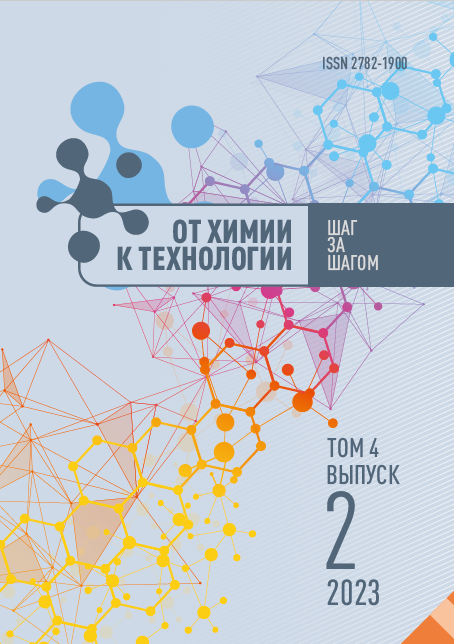Барнаул, Алтайский край, Россия
студент
Барнаул, Алтайский край, Россия
Increasing interest in the use of medicinal plants or their mixtures (herbal teas) in the prevention and treatment of diseases requires confirmation of the safety of the plants used. The reason is the heavy metals they contain can enter the human body together with the useful substances. The purpose of this paper is to determine the content of some heavy metals in medicinal plants produced by AltaiVita, Barnaul, Russia; KIMA, Barnaul, Russia, and PharmaCvet, Moscow, Russia by inversion voltammetry. The content of heavy metals we determined in 10 samples of medicinal plants from producer "AltaiVita". We preliminarily determined the moisture content of the examined raw material. The Cd content was 0.16-0.50 µg/kg, Pb - 0.33-0.85 µg/kg, Zn - 0.010-0.043 µg/kg, Cu - 10.1-55.9 mg/kg, that does not exceed maximum allowable content by standards of State Pharmacopoeia for medical plants and SanPiN 2.3.2.1078-01 for dietary supplements ("dried tea"). According to the standard content in plants (normal, average and toxic content of copper) exceeded in almost all samples (except for Cinquefoil white). We compared the content of heavy metals in samples of medicinal plants from AltaiVita, KIMA, and PharmaCvet. The content of Cd, Pb, Zn in KIMA and PharmaCvet samples was an order of magnitude or higher than the content of these metals in AltaiVita sam-ples; the content of Cu in AltaiVita samples was comparable or 2 times lower than in KIMA and PharmaCvet ones.
heavy metals, copper, zinc, cadmium, lead, medicinal plants, herbal teas, stripping voltammetry
1. Lebedeva, E.N. & Setko, N.P. (2017) Biochemistry of tea components and features of its biological action on the body (review), Orenburgskij medicinskij vestnik, (4) (in Russian).
2. Gravel, I.V., Yakovlev, G.P., Petrov, N.V., Stulovsky, S.S. & Listov, S.A. (1994) Content of heavy metals in some species of medicinal plants of Altai region, Rastitelnye resursy, (1-2), pp. 101-108 (in Russian).
3. Pivovarova, E.G., Konontseva, E.V., Gribov, S.I., Khludentsov, J.G., Domnikova, E.Yu. & Komyakova, E.M. (2015) Structure of soil cover of forest-steppe zone of Altai region under anthropogenesis, Vestnik AGAU, 11(133), pp. 36-42 (in Russian).
4. Vodyanitskiy, Y.N. (2008) Heavy metals and metalloids in soils. M.: Pochvennyy institut im. V.V. Dokuchayeva Rossiyskoy akademii selskokhozyaystvennykh nauk (in Russian).
5. Sigel, H. (1989) Concept on metals ion toxity. New York: Marsel Dekker Inc.
6. Vardhan, K.H., Kumar, P.S. & Panda, R.C. (2019) A review on heavy metal pollution, toxicity and remedial measures: current trends and future perspectives, J. Mol. Liq., (290): 111197. DOI:https://doi.org/10.1016/j.molliq.2019.111197.
7. Lindholm-Lehto, P. (2019) Biosorption of heavy metals by lignocellulosic biomass and chemical analysis, BioRes, 14(2), pp. 4952-4995. DOI:https://doi.org/10.15376/biores.14.2.Lindholm-Lehto.
8. Tereshkina, O.I., Rudakova, I.P., Gravel, I.V. & Samylina, I.A. (2010) The problem of rationing of heavy metals in medicinal plant raw materials, Farmaciya, (2), pp. 7-11 (in Russian).
9. Rozhdestvenskaya, T.A. (2003) Heavy metals in soils and plants of south-western part of Altai Krai: PhD. Barnaul (in Russian).
10. Sambukova, T.V., Ovchinnikov, B.V., Ganapolsky, V.P., Yatmanov, A.N. & Shabanov, P.D. (2017) Prospects of phytopreparations in modern pharmacology, Obzory po klinicheskoj farmakologii i lekarstvennoj terapii, 15(2), pp. 56-63 (in Russian).
11. Dmitriev, S.V. (1991) Study of the influence of some anthropogenic factors on the quality of wild plants: Abstract of thesis of Candidate of Pharmacological Sciences. M. (in Russian).
12. Kirichuk, G.E. (2006) Peculiarities of heavy metal ions accumulation in freshwater mollusks, Gidrobiol. Zhurnal, (42)4, pp. 99-106 (in Russian).
13. Seiler, H.G. (1994) Handbook on metals in clinical and analytical chemistry. New York: Marcel Dekker. Inc.
14. Kosman, V.M. & Pozharitskaya, O.N. (2015) Comparative study of the content of flavonoids and coumarins in some preparations of chamomile apothecary, Khimiya rastitelnogo syrya, (1) (in Russian).
15. Dobrovolsky, V.V. (1997) Biosphere cycles of heavy metals and the regulatory role of soil, Pochvovedenie, (4), pp 431-441 (in Russian).
16. Ilyin, V.B. (1991) Heavy metals in soil-plant system. Novosibirsk: Nauka (in Russian).
17. Herausgegeben, von E. Merian. (1984) Metalle in der Umwelt. Verteilung, Analytik und biologische Relevanz. Verlag Chemie. Weinheim-Deerfirld Benc: Florida-Basel.
18. Mudryi, I.V. (2003) Ecological and hygienic aspects of soil contamination with cadmium, Gigiena i sanitariya, (1), pp. 32-35 (in Russian).
19. Tursi, A. (2019) A review on biomass: importance, chemistry, classification, and conversion, Biofuel Res. J., (6), pp. 962-979. DOI:https://doi.org/10.18331/BRJ2019.6.2.3.
20. Nikiforova, T.E., Vokurova, D.A. & Sofronov, A.R. (2022) Extraction of copper ions by sorbent based on flax fiber modified by L-arginine, From Chemistry Towards Technology Step-By-Step, 3(3). DOI:https://doi.org/10.52957/27821900 2022.03.17 [online]. Available at: http://chemintech.ru/index.php/tor/2022tom3no3 (in Russian).
21. Vasak, M. & Kagi, J.H. (1983) Spectroscopic properties of metallothionein, Metal Ions Biol. Syst., (15), pp. 213-273.
22. Reut, A.A. (2019) The content of biologically active metabolites in different raw materials of some species and varieties of peony, Rol metabolomiki v sovershenstvovanii biotekhnologicheskih sredstv proizvodstva: Materialy II mezhdunar. nauch. konf. Moskva, 6–7 iyunya 2019 goda. M.: Vserossijskij nauchno-issledovatelskij institut lekarstvennyh i aromaticheskih rastenij, pp. 201-206 (in Russian).
23. Chistokhin, Y.G., Khalfina, P.D. & Tantsereva, I.G. (2000) Voltamperometry as one of the methods of determination of heavy metals in objects, Farmacevticheskaya nauka i praktika: materialy nauch.-prakt. konf. Keme-rovo, pp. 160-162 (in Russian).
24. (2015) Determination of moisture content. General Pharmacopoeia. 1.5.3.0007.15 of medicinal plant raw mate-rials and medicinal plant preparations, Gosudarstvennaya farmakopeya Rossijskoj Federacii. XIII izdanie, (II) (in Russian).
25. Antonova, N.P., Morgunov, I.M., Prokhvatilova, S.S., Shefer, E.P. & Kalinin, A.M. (2017) Application of an alternative method for determining moisture in herbal medicines, Vedomosti Nauchnogo centra ekspertizy sredstv medicinskogo primeneniya, 7(3), pp. 182-185 (in Russian).
26. MU 31-04/04. (2004) Kolichestvennyj himicheskij analiz prob pishchevyh produktov, prodovol'stvennogo syrya, kormov i produktov ih pererabotki, biologicheski aktivnyh dobavok k pishche, biologicheskih obiektov. Tomsk: Izd-vo TPU (in Russian).
27. (2015) Gosudarstvennaya Farmakopeya RF. XIII izd. / MZ RF. M. (in Russian).
28. (2001) SanPin 2.3.2.1078-01. Gigienicheskie trebovaniya k bezopasnosti i pishchevoj cennosti produktov. M. (in Russian).
29. Baker, D.E. & Chesnin, L. (1975) Chemical monitoring of soil for environmental quality animal and health, Advances in Agronomy, (27), pp. 306-366.







